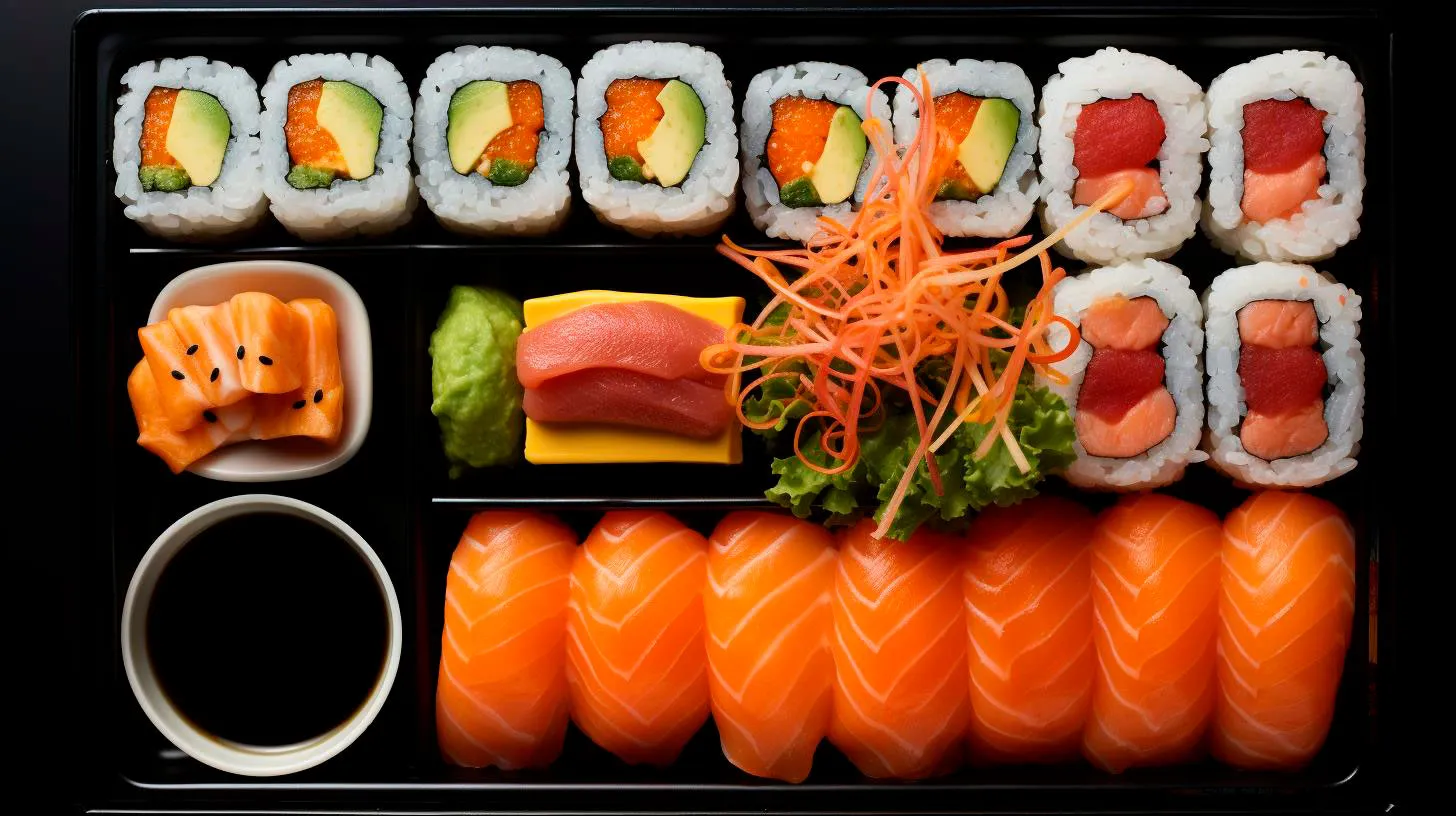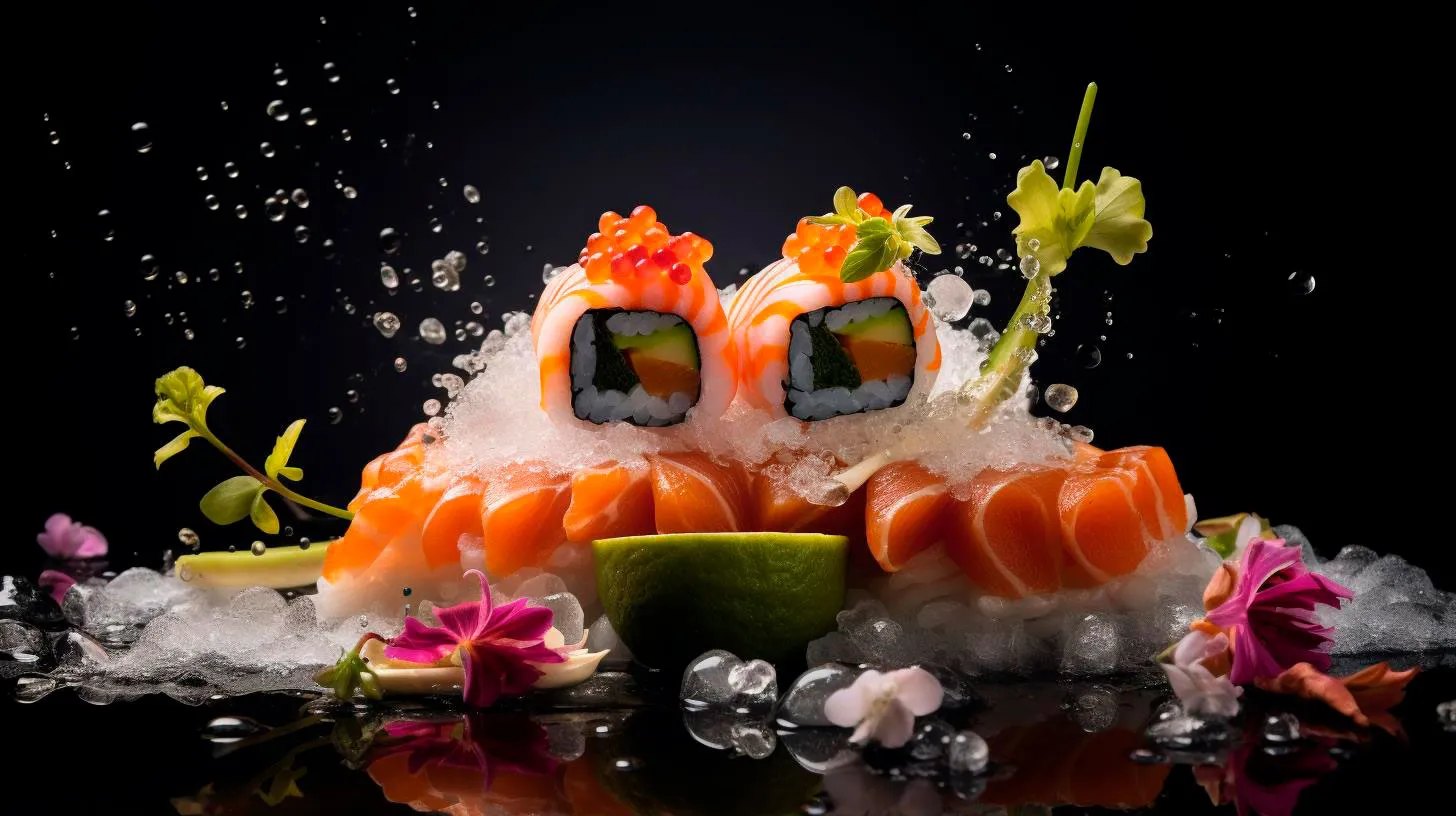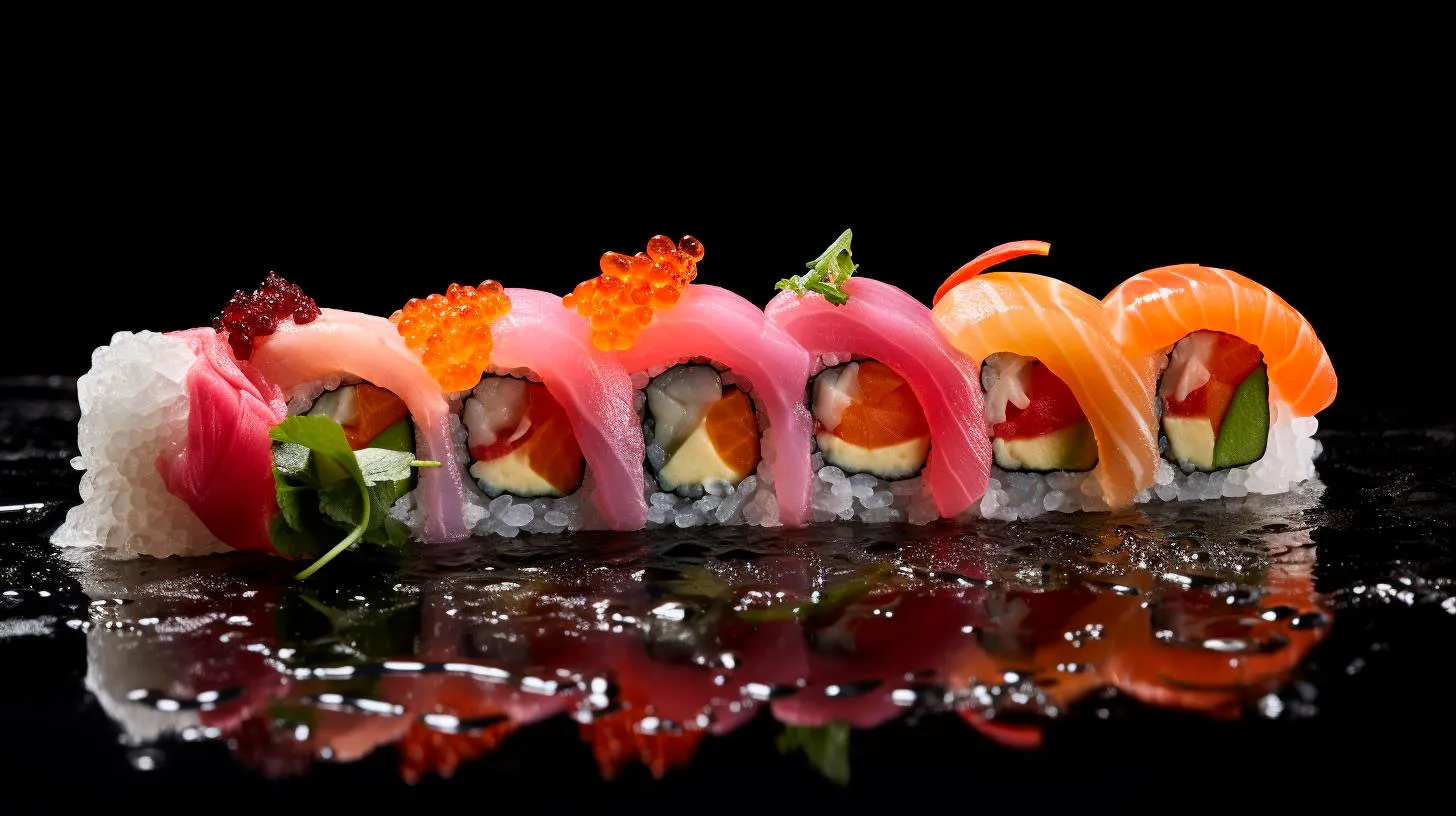Nori and Rice: A Versatile Duo in Japanese Cuisine
This article explores the unique characteristics, health benefits, and versatility of nori and rice, shedding light on the integral role they play in Japanese gastronomy.
The Allure of Nori
Nori, often referred to as a “sea vegetable,” is harvested from the coastal waters of Japan. With its distinct taste and versatility, nori has become a beloved ingredient in Japanese cuisine and has gained popularity worldwide. Here are some key features and advantages of nori:
- Nutrient Powerhouse: Nori is rich in essential vitamins and minerals, including vitamin C, potassium, iodine, and calcium.
- Umami Flavor: The unique taste of nori, known as umami, adds depth and complexity to dishes, enhancing their overall flavor profile.
- Convenient Packaging: Nori is commonly available in thin, dark green sheets that are easily accessible and can be stored for extended periods.
- Seaweed Harvesting Sustainability: Nori farming has a minimal impact on the marine ecosystem, making it an eco-friendly choice compared to certain forms of fishing.
Nori’s versatility knows no bounds, as it finds its way into a myriad of Japanese dishes. Whether it’s used as a crunchy wrap for sushi, sprinkled on a bowl of noodles, or crumbled over a salad, nori brings a delightful oceanic touch to each bite, making it a must-have ingredient for seafood enthusiasts and vegetarians alike.
Rice: The Pillar of Japanese Cuisine
Rice, or gohan in Japanese, is a fundamental component of Japanese cuisine. It serves as the base for many traditional dishes and is integral to the country’s culinary identity. Here are some reasons why rice is a staple ingredient in Japanese cuisine:
- Cultural Significance: Rice cultivation has deep roots in Japanese culture and has been a fundamental aspect of daily life for centuries.
- Nutritional Value: Packed with carbohydrates, fiber, and essential nutrients, rice provides a sustainable source of energy and aids in digestion.
- Food Versatility: Rice can be prepared in various ways, including sushi rice, steamed rice, fried rice, and rice porridge. Its adaptability makes it suitable for an array of dishes.
- Gluten-Free Option: For those with gluten sensitivities or dietary restrictions, rice serves as a reliable and delicious alternative to wheat-based grains.
With its neutral flavor, rice acts as a canvas for other ingredients, allowing flavors to meld harmoniously. From delicate sushi nigiri to comforting bowls of steaming rice topped with flavorful meats or vegetables, this humble grain serves as the foundation for countless Japanese dishes, providing sustenance, texture, and balance.
A Harmonious Duo
When nori and rice unite, a perfect culinary symphony ensues, creating some of the most beloved and iconic Japanese dishes. Here are a few examples:
- Sushi Rolls: Nori is wrapped around vinegared rice, providing a convenient and tasty vessel for fresh seafood, vegetables, or other fillings. Sushi rolls, or maki, come in a variety of enticing combinations.
- Onigiri: These delicious rice balls are often wrapped in a sheet of nori and filled with a diverse range of ingredients such as pickled plums, grilled salmon, or seasoned seaweed.
- Nori Snacks: Roasted nori sheets sprinkled with seasonings like salt or sesame seeds are popular as a snack in Japan. They can be enjoyed as a standalone treat or crumbled and used to enhance the flavor of various dishes.
Together, nori and rice create a symphony of flavors, textures, and nutritional benefits, making them an inseparable duo in Japanese cuisine that continues to enthrall gastronomy enthusiasts worldwide.
The Way Forward
As the popularity of Japanese cuisine continues to soar globally, understanding the key ingredients that define its flavors becomes essential. Nori and rice, both dynamic and versatile, provide a unique combination that forms the backbone of many beloved dishes.
By exploring the individual characteristics and advantages of nori and rice, we can gain a deeper appreciation for the rich tapestry of flavors and techniques woven into Japanese gastronomy.
So, whether you’re tantalized by the allure of sushi rolls or yearning for a comforting onigiri, embrace the magic of nori and rice as they transport you to the vibrant world of Japanese cuisine.
Exploring the Origins of Sushi Nori and Rice
So, grab your chopsticks and get ready to embark on this culinary journey!
The Ancient Beginnings of Nori
Nori, the thin and delicate seaweed sheets used to wrap sushi rolls, has a rich history that dates back centuries. It is believed that the production of nori originated in Japan during the Nara Period (710-794 AD) when the Japanese began cultivating seaweed along their coastlines.
Initially, nori was not used for sushi but rather as an additive to soups and as a food garnish. It was only during the Edo Period (1603-1868 AD) that nori started being used to wrap sushi, specifically nigiri sushi. The innovation of using nori transformed sushi into a handheld, convenient snack.
The Rise of Rice
Rice, the pillar of Japanese cuisine, has its own story to tell. It is believed that rice cultivation in Japan began around 300 BC, and it quickly became a staple food due to its versatility and nutritional value. Initially, rice was consumed as a porridge or boiled grain, but over time, the Japanese discovered new ways to prepare and enjoy this crop.
During the Muromachi Period (1336-1573 AD), vinegar was introduced to the rice, creating “sour rice” or what we now know as sushi rice. This fermentation process allowed the rice to last longer, making it possible to transport it across long distances. This development was crucial in enabling the widespread popularity of sushi.
The Perfect Marriage
The combination of nori and rice was a game-changer in the world of sushi. It not only enhanced the taste but also revolutionized the way sushi was consumed. The seaweed acted as a natural barrier, preventing the rice from falling apart and making it easier to handle and eat.
Thanks to its high nutritional value, nori is not just used for wrapping sushi but is also enjoyed as a standalone snack. Nori is packed with minerals such as iodine, iron, and calcium, making it a healthy choice as well.
Advantages of Nori and Rice
- Nori provides a unique umami flavor, enhancing the overall taste of sushi rolls.
- Both nori and rice are gluten-free, making them suitable options for individuals with dietary restrictions.
- The combination of seaweed and rice offers an abundant source of essential vitamins and minerals.
The Global Spread of Sushi
As the popularity of sushi grew in Japan, it eventually made its way to other parts of the world. In the early 20th century, Japanese immigrants introduced sushi to the United States, starting with California. However, it was not until the 1980s that sushi gained widespread popularity in the West.
Today, sushi has transformed into a global phenomenon, with sushi bars and restaurants available in almost every major city around the world. The combination of nori and rice is the foundation of various sushi creations, such as maki rolls, nigiri sushi, and temaki.
Key Takeaways
- Nori and rice are two essential components of sushi, originating from Japan.
- Nori was initially used as a food garnish and became popular for sushi wrapping during the Edo Period.
- Rice cultivation started in Japan around 300 BC, and sushi rice emerged during the Muromachi Period.
- The combination of nori and rice revolutionized sushi, making it a portable and convenient dish.
- Sushi has become a global phenomenon, available in various forms worldwide.
So, the next time you savor a delicious sushi roll, take a moment to appreciate the origins of nori and rice. These humble ingredients have come a long way to bring joy and satisfaction to sushi enthusiasts all over the globe. As we celebrate the rich history and artistry behind sushi, let’s also enjoy the unique flavors and textures that make it such a beloved culinary delight.
The Health Benefits of Nori and Rice
The Nutritional Powerhouses: Nori and Rice
Nori is packed with essential vitamins and minerals, making it a valuable addition to any diet. Here are some key nutrients found in nori:
- Vitamin A – Supports healthy vision and immune function.
- Vitamin C – Boosts collagen production and strengthens the immune system.
- Vitamin B12 – Vital for neurological function and red blood cell production.
- Fiber – Promotes digestion and helps maintain healthy cholesterol levels.
- Calcium – Necessary for strong bones and teeth.
- Iodine – Critical for thyroid function and hormone production.
- Iron – Essential for oxygen transport in the body.
On the other hand, rice is a versatile grain that offers several nutritional benefits:
- Complex Carbohydrates – Provides a steady release of energy.
- B Vitamins – Supports energy production and brain function.
- Fiber – Aids digestion and helps control blood sugar levels.
- Phosphorus – Necessary for strong bones and teeth.
- Magnesium – Supports muscle and nerve function.
- Iron – Helps transport oxygen throughout the body.
- Protein – Essential for the growth and repair of tissues.
The Health Benefits:
1. Rich in Antioxidants
Nori and rice both contain antioxidants, which help protect the body from damage caused by harmful free radicals. Antioxidants play a crucial role in reducing the risk of chronic diseases such as heart disease, certain cancers, and inflammation.
2. Supports Digestive Health
The fiber content in nori and rice promotes healthy digestion. Fiber adds bulk to the diet, preventing constipation, and supporting regular bowel movements. Additionally, nori contains a type of fiber called carrageenan, known to have prebiotic properties that nourish beneficial gut bacteria.
3. Boosts Immune Function
The combination of vitamins and minerals in nori and rice enhances the immune system’s response. Vitamin C found in nori stimulates the production of white blood cells, while vitamin A supports the integrity of mucosal surfaces as a defense against pathogens. These nutrients help protect the body from infections and illnesses.
4. Supports Brain Health
Both nori and rice contain nutrients crucial for brain health. Vitamin B12 found in nori is important for neurological function and maintaining healthy nerve cells. Rice provides B vitamins, including thiamine and niacin, which are essential for brain development and cognitive function.
5. Heart-Healthy
Consuming nori and rice as part of a balanced diet can contribute to heart health. Both foods are low in saturated fats and cholesterol. The fiber content in nori and rice helps maintain healthy cholesterol levels, reducing the risk of heart disease.
Key Takeaways:
- Nori and rice are nutritional powerhouses, providing a range of essential vitamins and minerals.
- Both foods offer antioxidant properties, supporting overall health and reducing the risk of chronic diseases.
- The fiber content in nori and rice promotes digestive health and regular bowel movements.
- Nori and rice enhance immune function and protect against infections and illnesses.
- The combination of nutrients in these foods supports brain health and cognitive function.
- Incorporating nori and rice into a balanced diet can contribute to heart health.
So, the next time you’re looking for a nourishing and flavorful meal, consider the health benefits of nori and rice. This culinary duo not only satisfies your taste buds but also supports your overall well-being.
Mastering the Art of Rolling Sushi Nori and Rice Techniques
The Art of Rolling Sushi Nori
Sushi nori, or seaweed, is the delicate wrapping around the sushi rolls that gives them their characteristic flavor and appearance. Rolling sushi nori correctly requires a meticulous approach to achieve the perfect balance of taste and texture. Here are some key tips to help you roll sushi nori like a pro:
- Quality Matters: Begin with high-quality sushi nori sheets to ensure a pleasant dining experience.
- Nori Placement: Place the shiny side of the nori sheet facing down on a clean bamboo sushi mat.
- Even Rice Distribution: Spread a thin, even layer of sushi rice over the nori, ensuring that it covers the entire sheet.
- Moist Hands: Keep a small bowl of water nearby to wet your hands frequently. This prevents the rice from sticking to your hands.
- Precise Rolling: Roll the sushi snugly using the sushi mat, exerting gentle pressure to maintain the shape and prevent unraveling.
Mastering the art of rolling sushi nori requires practice and patience. Follow these techniques, and soon you’ll be creating beautifully rolled sushi rolls that are both visually stunning and delicious.
Perfecting Rice Techniques
The foundation of every great sushi roll lies in perfectly cooked rice. Sushi rice is a specific type of short-grain rice that is sticky and seasoned with vinegar, salt, and sugar. Here are some essential points to keep in mind when preparing the rice:
- Rinsing: Thoroughly rinse the rice until the water runs clear to remove excess starch.
- Proportions: Use the ideal rice-to-water ratio. Typically, it is 1:1.25 (one cup of rice to 1.25 cups of water).
- Cooking: Cook the rice in a rice cooker or stovetop pot, following the instructions for the best results.
- Seasoning: Mix rice vinegar, sugar, and salt in a separate bowl and gently fold it into the cooked rice. Be cautious not to mash or break the grains.
- Cooling: Allow the sushi rice to cool to room temperature before using it for rolling.
Remember, the quality of sushi largely depends on the texture and taste of the rice. Mastering these rice techniques will elevate your sushi-rolling skills to new heights.
Key Takeaways
As we conclude this gastronomic journey into rolling sushi nori and rice techniques, here are some key takeaways:
- Use high-quality sushi nori sheets to enhance the flavor and appearance of your sushi rolls.
- Ensure an even distribution of rice, covering the entire nori sheet.
- Keep your hands moist while handling the rice to prevent it from sticking.
- Roll the sushi tightly, exerting gentle pressure to maintain its shape.
- Rinse the rice thoroughly and use the perfect rice-to-water ratio for fluffy sushi rice.
- Season the rice with the right balance of vinegar, sugar, and salt for authentic sushi taste.
Now that you are armed with these valuable techniques and insights, it’s time to roll up your sleeves and embark on your sushi-rolling adventure. Practice makes perfect, so grab your sushi mat, ingredients, and let your culinary creativity soar!



